Floodplain Risk Management in NSW: A1 Report - Risk and Strategy
VerifiedAdded on 2020/02/18
|21
|5562
|77
Report
AI Summary
This report provides a detailed analysis of floodplain risk management in New South Wales (NSW), Australia. It begins with an introduction to flooding as a natural disaster in Australia, highlighting its historical development and significant impacts on lives and property. The report defines risk and risk management, emphasizing the importance of understanding flood behavior for effective decision-making. It explores the merit-based approach and strategic assessment, key components of NSW's flood management policies, and outlines the floodplain risk management process, including the roles of the FRM committee, data collection, flood studies, and plan implementation. The report also examines the floodplain risk management framework, addressing key issues such as risk management methodology, governance, and the importance of understanding flood behavior. It identifies key end-users and their information needs, and analyzes the involvement of federal, state, and local governments in floodplain risk management. Overall, the report provides a comprehensive overview of the current state of floodplain risk management in NSW, emphasizing the need for strategic approaches to minimize the impacts of flooding.
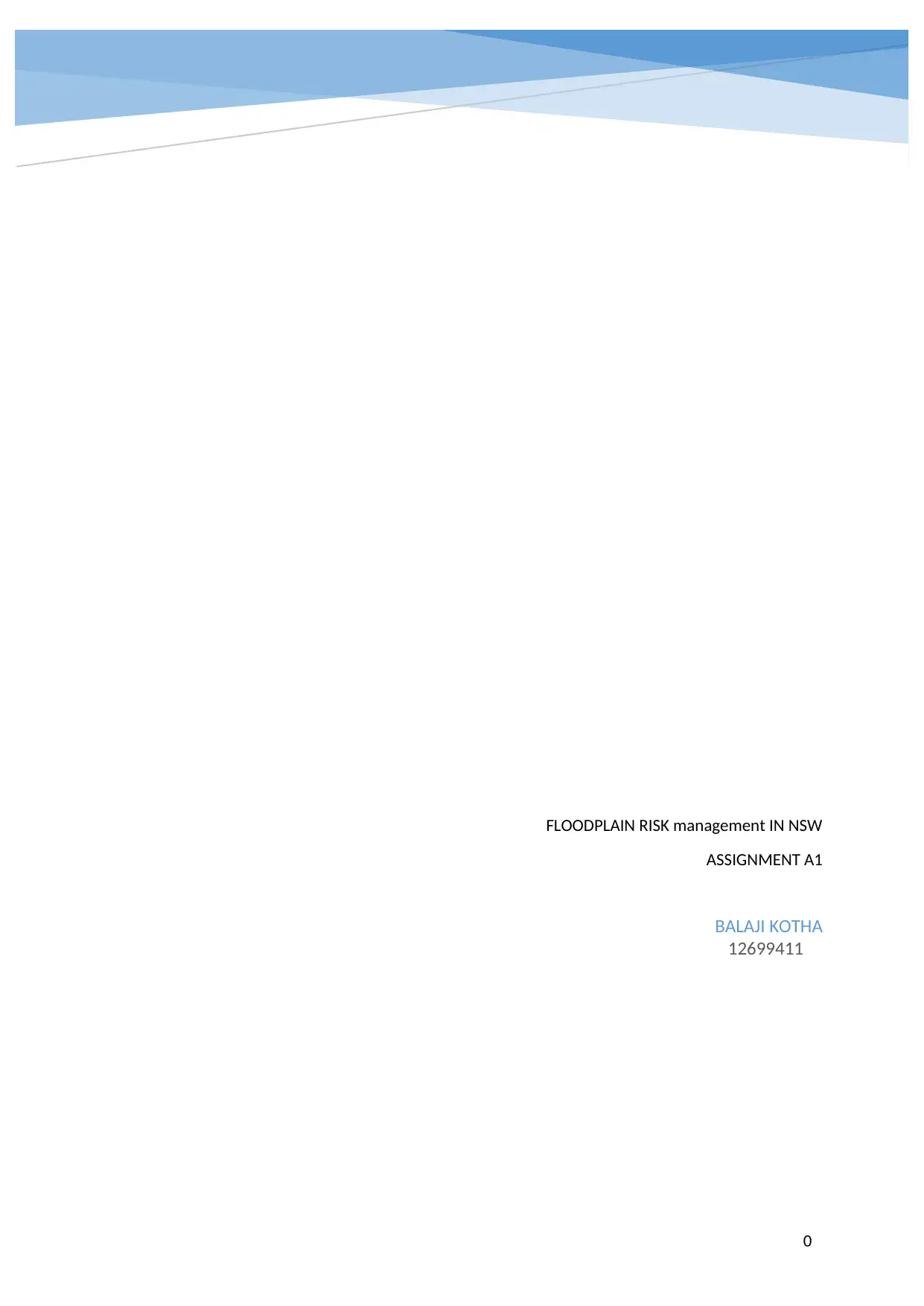
FLOODPLAIN RISK management IN NSW
ASSIGNMENT A1
BALAJI KOTHA
12699411
0
ASSIGNMENT A1
BALAJI KOTHA
12699411
0
Paraphrase This Document
Need a fresh take? Get an instant paraphrase of this document with our AI Paraphraser
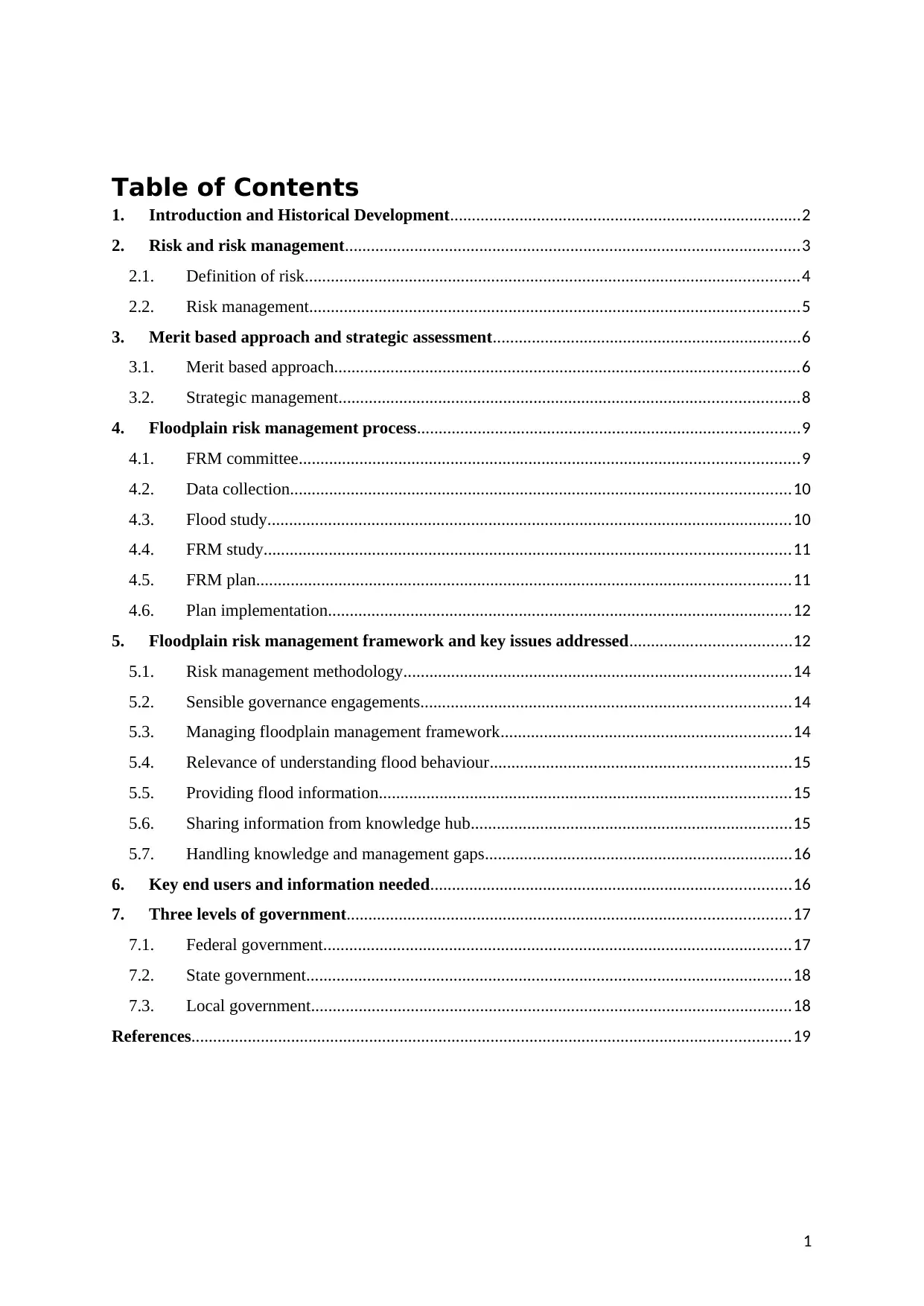
Table of Contents
1. Introduction and Historical Development.................................................................................2
2. Risk and risk management.........................................................................................................3
2.1. Definition of risk..................................................................................................................4
2.2. Risk management.................................................................................................................5
3. Merit based approach and strategic assessment.......................................................................6
3.1. Merit based approach...........................................................................................................6
3.2. Strategic management..........................................................................................................8
4. Floodplain risk management process........................................................................................9
4.1. FRM committee...................................................................................................................9
4.2. Data collection...................................................................................................................10
4.3. Flood study.........................................................................................................................10
4.4. FRM study.........................................................................................................................11
4.5. FRM plan...........................................................................................................................11
4.6. Plan implementation...........................................................................................................12
5. Floodplain risk management framework and key issues addressed.....................................12
5.1. Risk management methodology.........................................................................................14
5.2. Sensible governance engagements.....................................................................................14
5.3. Managing floodplain management framework...................................................................14
5.4. Relevance of understanding flood behaviour.....................................................................15
5.5. Providing flood information...............................................................................................15
5.6. Sharing information from knowledge hub..........................................................................15
5.7. Handling knowledge and management gaps.......................................................................16
6. Key end users and information needed...................................................................................16
7. Three levels of government......................................................................................................17
7.1. Federal government............................................................................................................17
7.2. State government................................................................................................................18
7.3. Local government...............................................................................................................18
References..........................................................................................................................................19
1
1. Introduction and Historical Development.................................................................................2
2. Risk and risk management.........................................................................................................3
2.1. Definition of risk..................................................................................................................4
2.2. Risk management.................................................................................................................5
3. Merit based approach and strategic assessment.......................................................................6
3.1. Merit based approach...........................................................................................................6
3.2. Strategic management..........................................................................................................8
4. Floodplain risk management process........................................................................................9
4.1. FRM committee...................................................................................................................9
4.2. Data collection...................................................................................................................10
4.3. Flood study.........................................................................................................................10
4.4. FRM study.........................................................................................................................11
4.5. FRM plan...........................................................................................................................11
4.6. Plan implementation...........................................................................................................12
5. Floodplain risk management framework and key issues addressed.....................................12
5.1. Risk management methodology.........................................................................................14
5.2. Sensible governance engagements.....................................................................................14
5.3. Managing floodplain management framework...................................................................14
5.4. Relevance of understanding flood behaviour.....................................................................15
5.5. Providing flood information...............................................................................................15
5.6. Sharing information from knowledge hub..........................................................................15
5.7. Handling knowledge and management gaps.......................................................................16
6. Key end users and information needed...................................................................................16
7. Three levels of government......................................................................................................17
7.1. Federal government............................................................................................................17
7.2. State government................................................................................................................18
7.3. Local government...............................................................................................................18
References..........................................................................................................................................19
1
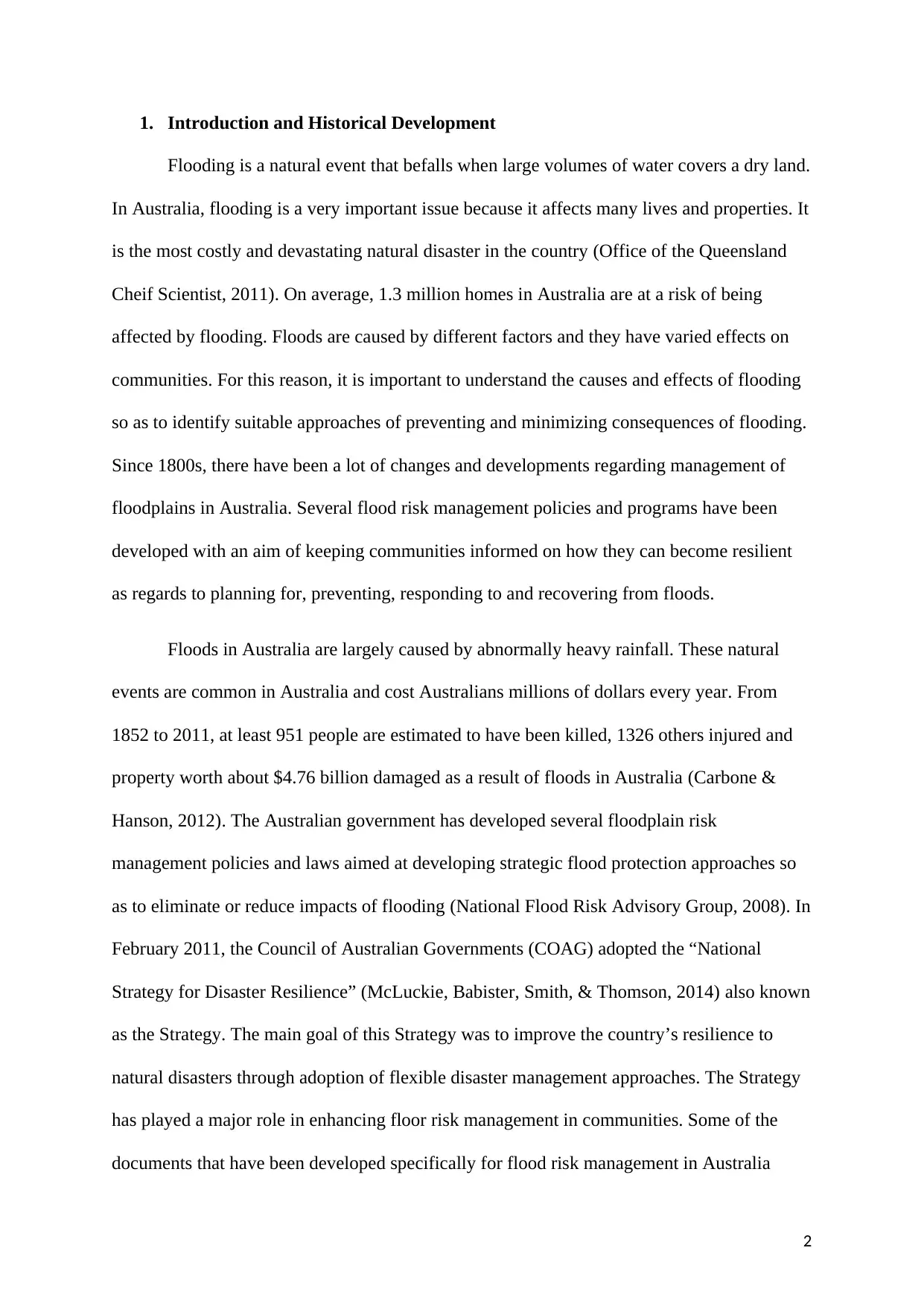
1. Introduction and Historical Development
Flooding is a natural event that befalls when large volumes of water covers a dry land.
In Australia, flooding is a very important issue because it affects many lives and properties. It
is the most costly and devastating natural disaster in the country (Office of the Queensland
Cheif Scientist, 2011). On average, 1.3 million homes in Australia are at a risk of being
affected by flooding. Floods are caused by different factors and they have varied effects on
communities. For this reason, it is important to understand the causes and effects of flooding
so as to identify suitable approaches of preventing and minimizing consequences of flooding.
Since 1800s, there have been a lot of changes and developments regarding management of
floodplains in Australia. Several flood risk management policies and programs have been
developed with an aim of keeping communities informed on how they can become resilient
as regards to planning for, preventing, responding to and recovering from floods.
Floods in Australia are largely caused by abnormally heavy rainfall. These natural
events are common in Australia and cost Australians millions of dollars every year. From
1852 to 2011, at least 951 people are estimated to have been killed, 1326 others injured and
property worth about $4.76 billion damaged as a result of floods in Australia (Carbone &
Hanson, 2012). The Australian government has developed several floodplain risk
management policies and laws aimed at developing strategic flood protection approaches so
as to eliminate or reduce impacts of flooding (National Flood Risk Advisory Group, 2008). In
February 2011, the Council of Australian Governments (COAG) adopted the “National
Strategy for Disaster Resilience” (McLuckie, Babister, Smith, & Thomson, 2014) also known
as the Strategy. The main goal of this Strategy was to improve the country’s resilience to
natural disasters through adoption of flexible disaster management approaches. The Strategy
has played a major role in enhancing floor risk management in communities. Some of the
documents that have been developed specifically for flood risk management in Australia
2
Flooding is a natural event that befalls when large volumes of water covers a dry land.
In Australia, flooding is a very important issue because it affects many lives and properties. It
is the most costly and devastating natural disaster in the country (Office of the Queensland
Cheif Scientist, 2011). On average, 1.3 million homes in Australia are at a risk of being
affected by flooding. Floods are caused by different factors and they have varied effects on
communities. For this reason, it is important to understand the causes and effects of flooding
so as to identify suitable approaches of preventing and minimizing consequences of flooding.
Since 1800s, there have been a lot of changes and developments regarding management of
floodplains in Australia. Several flood risk management policies and programs have been
developed with an aim of keeping communities informed on how they can become resilient
as regards to planning for, preventing, responding to and recovering from floods.
Floods in Australia are largely caused by abnormally heavy rainfall. These natural
events are common in Australia and cost Australians millions of dollars every year. From
1852 to 2011, at least 951 people are estimated to have been killed, 1326 others injured and
property worth about $4.76 billion damaged as a result of floods in Australia (Carbone &
Hanson, 2012). The Australian government has developed several floodplain risk
management policies and laws aimed at developing strategic flood protection approaches so
as to eliminate or reduce impacts of flooding (National Flood Risk Advisory Group, 2008). In
February 2011, the Council of Australian Governments (COAG) adopted the “National
Strategy for Disaster Resilience” (McLuckie, Babister, Smith, & Thomson, 2014) also known
as the Strategy. The main goal of this Strategy was to improve the country’s resilience to
natural disasters through adoption of flexible disaster management approaches. The Strategy
has played a major role in enhancing floor risk management in communities. Some of the
documents that have been developed specifically for flood risk management in Australia
2
⊘ This is a preview!⊘
Do you want full access?
Subscribe today to unlock all pages.

Trusted by 1+ million students worldwide
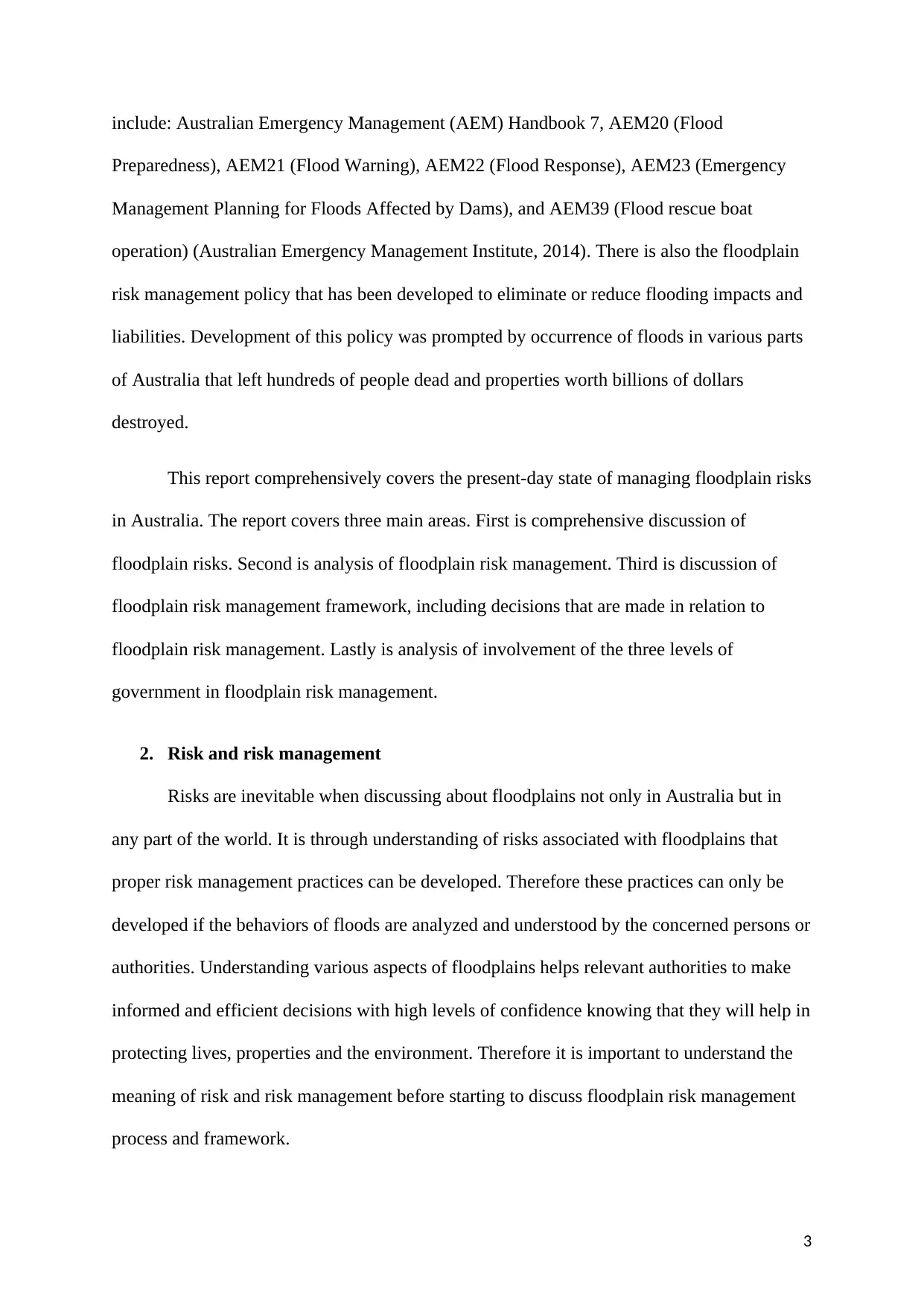
include: Australian Emergency Management (AEM) Handbook 7, AEM20 (Flood
Preparedness), AEM21 (Flood Warning), AEM22 (Flood Response), AEM23 (Emergency
Management Planning for Floods Affected by Dams), and AEM39 (Flood rescue boat
operation) (Australian Emergency Management Institute, 2014). There is also the floodplain
risk management policy that has been developed to eliminate or reduce flooding impacts and
liabilities. Development of this policy was prompted by occurrence of floods in various parts
of Australia that left hundreds of people dead and properties worth billions of dollars
destroyed.
This report comprehensively covers the present-day state of managing floodplain risks
in Australia. The report covers three main areas. First is comprehensive discussion of
floodplain risks. Second is analysis of floodplain risk management. Third is discussion of
floodplain risk management framework, including decisions that are made in relation to
floodplain risk management. Lastly is analysis of involvement of the three levels of
government in floodplain risk management.
2. Risk and risk management
Risks are inevitable when discussing about floodplains not only in Australia but in
any part of the world. It is through understanding of risks associated with floodplains that
proper risk management practices can be developed. Therefore these practices can only be
developed if the behaviors of floods are analyzed and understood by the concerned persons or
authorities. Understanding various aspects of floodplains helps relevant authorities to make
informed and efficient decisions with high levels of confidence knowing that they will help in
protecting lives, properties and the environment. Therefore it is important to understand the
meaning of risk and risk management before starting to discuss floodplain risk management
process and framework.
3
Preparedness), AEM21 (Flood Warning), AEM22 (Flood Response), AEM23 (Emergency
Management Planning for Floods Affected by Dams), and AEM39 (Flood rescue boat
operation) (Australian Emergency Management Institute, 2014). There is also the floodplain
risk management policy that has been developed to eliminate or reduce flooding impacts and
liabilities. Development of this policy was prompted by occurrence of floods in various parts
of Australia that left hundreds of people dead and properties worth billions of dollars
destroyed.
This report comprehensively covers the present-day state of managing floodplain risks
in Australia. The report covers three main areas. First is comprehensive discussion of
floodplain risks. Second is analysis of floodplain risk management. Third is discussion of
floodplain risk management framework, including decisions that are made in relation to
floodplain risk management. Lastly is analysis of involvement of the three levels of
government in floodplain risk management.
2. Risk and risk management
Risks are inevitable when discussing about floodplains not only in Australia but in
any part of the world. It is through understanding of risks associated with floodplains that
proper risk management practices can be developed. Therefore these practices can only be
developed if the behaviors of floods are analyzed and understood by the concerned persons or
authorities. Understanding various aspects of floodplains helps relevant authorities to make
informed and efficient decisions with high levels of confidence knowing that they will help in
protecting lives, properties and the environment. Therefore it is important to understand the
meaning of risk and risk management before starting to discuss floodplain risk management
process and framework.
3
Paraphrase This Document
Need a fresh take? Get an instant paraphrase of this document with our AI Paraphraser
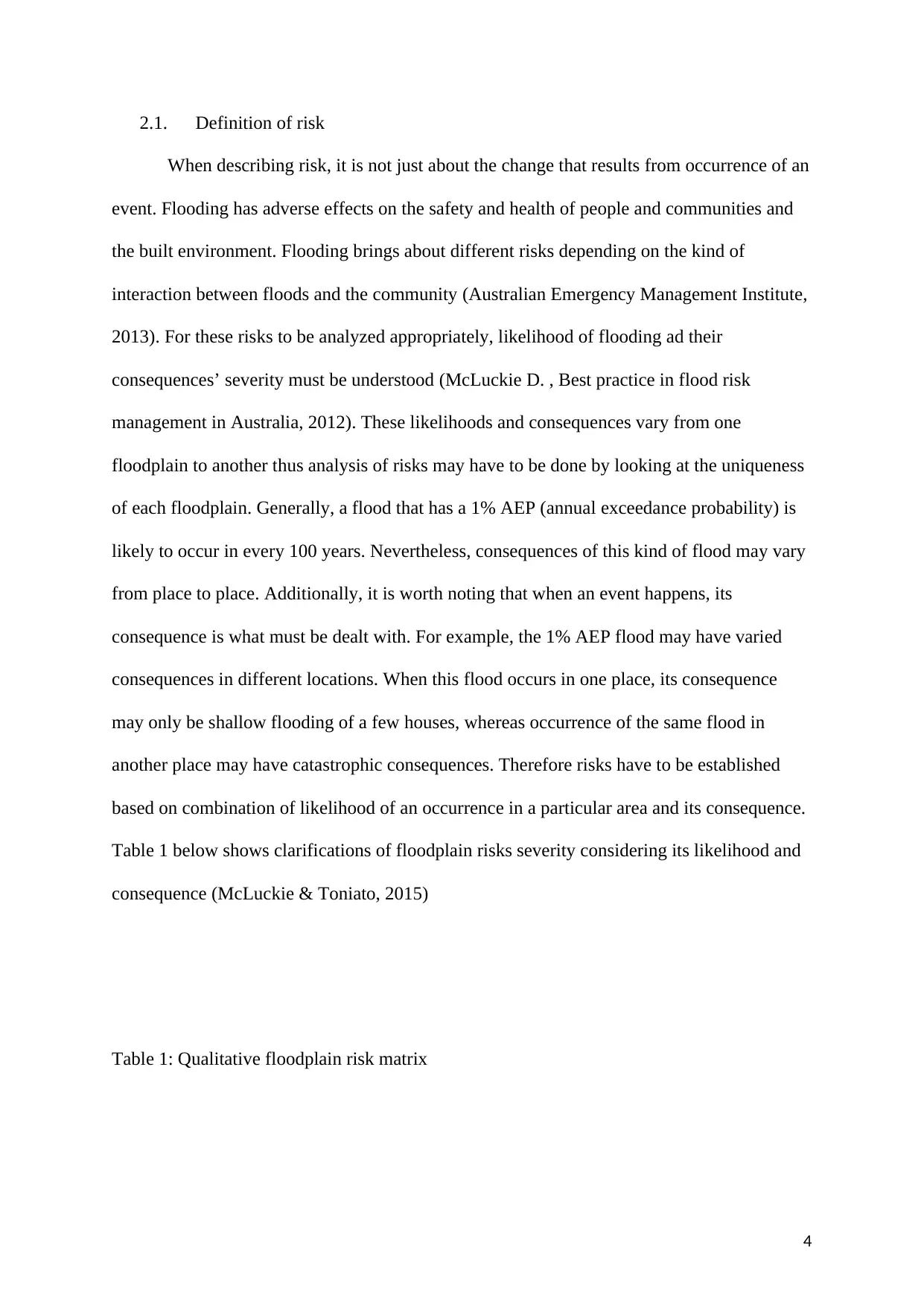
2.1. Definition of risk
When describing risk, it is not just about the change that results from occurrence of an
event. Flooding has adverse effects on the safety and health of people and communities and
the built environment. Flooding brings about different risks depending on the kind of
interaction between floods and the community (Australian Emergency Management Institute,
2013). For these risks to be analyzed appropriately, likelihood of flooding ad their
consequences’ severity must be understood (McLuckie D. , Best practice in flood risk
management in Australia, 2012). These likelihoods and consequences vary from one
floodplain to another thus analysis of risks may have to be done by looking at the uniqueness
of each floodplain. Generally, a flood that has a 1% AEP (annual exceedance probability) is
likely to occur in every 100 years. Nevertheless, consequences of this kind of flood may vary
from place to place. Additionally, it is worth noting that when an event happens, its
consequence is what must be dealt with. For example, the 1% AEP flood may have varied
consequences in different locations. When this flood occurs in one place, its consequence
may only be shallow flooding of a few houses, whereas occurrence of the same flood in
another place may have catastrophic consequences. Therefore risks have to be established
based on combination of likelihood of an occurrence in a particular area and its consequence.
Table 1 below shows clarifications of floodplain risks severity considering its likelihood and
consequence (McLuckie & Toniato, 2015)
Table 1: Qualitative floodplain risk matrix
4
When describing risk, it is not just about the change that results from occurrence of an
event. Flooding has adverse effects on the safety and health of people and communities and
the built environment. Flooding brings about different risks depending on the kind of
interaction between floods and the community (Australian Emergency Management Institute,
2013). For these risks to be analyzed appropriately, likelihood of flooding ad their
consequences’ severity must be understood (McLuckie D. , Best practice in flood risk
management in Australia, 2012). These likelihoods and consequences vary from one
floodplain to another thus analysis of risks may have to be done by looking at the uniqueness
of each floodplain. Generally, a flood that has a 1% AEP (annual exceedance probability) is
likely to occur in every 100 years. Nevertheless, consequences of this kind of flood may vary
from place to place. Additionally, it is worth noting that when an event happens, its
consequence is what must be dealt with. For example, the 1% AEP flood may have varied
consequences in different locations. When this flood occurs in one place, its consequence
may only be shallow flooding of a few houses, whereas occurrence of the same flood in
another place may have catastrophic consequences. Therefore risks have to be established
based on combination of likelihood of an occurrence in a particular area and its consequence.
Table 1 below shows clarifications of floodplain risks severity considering its likelihood and
consequence (McLuckie & Toniato, 2015)
Table 1: Qualitative floodplain risk matrix
4
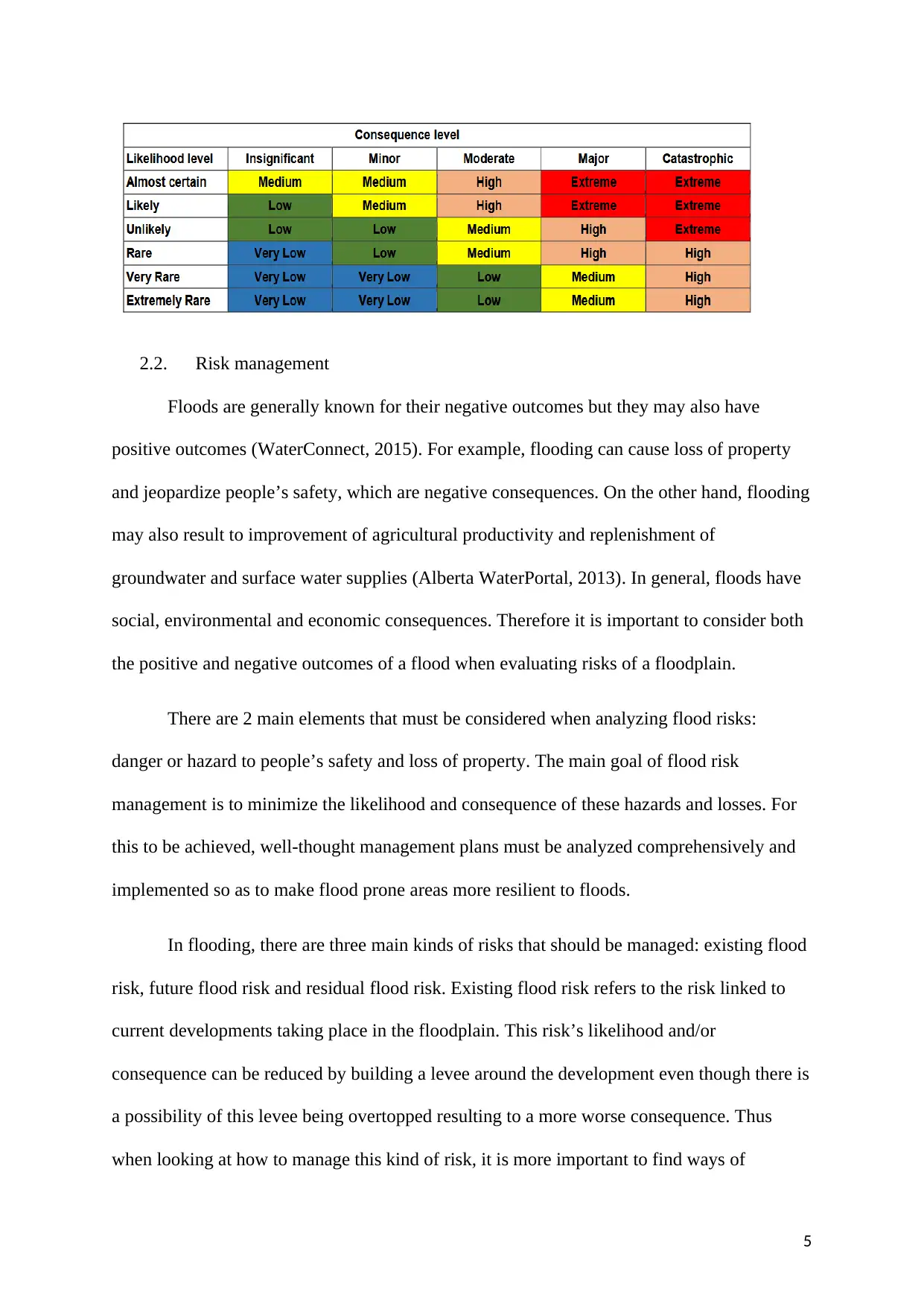
2.2. Risk management
Floods are generally known for their negative outcomes but they may also have
positive outcomes (WaterConnect, 2015). For example, flooding can cause loss of property
and jeopardize people’s safety, which are negative consequences. On the other hand, flooding
may also result to improvement of agricultural productivity and replenishment of
groundwater and surface water supplies (Alberta WaterPortal, 2013). In general, floods have
social, environmental and economic consequences. Therefore it is important to consider both
the positive and negative outcomes of a flood when evaluating risks of a floodplain.
There are 2 main elements that must be considered when analyzing flood risks:
danger or hazard to people’s safety and loss of property. The main goal of flood risk
management is to minimize the likelihood and consequence of these hazards and losses. For
this to be achieved, well-thought management plans must be analyzed comprehensively and
implemented so as to make flood prone areas more resilient to floods.
In flooding, there are three main kinds of risks that should be managed: existing flood
risk, future flood risk and residual flood risk. Existing flood risk refers to the risk linked to
current developments taking place in the floodplain. This risk’s likelihood and/or
consequence can be reduced by building a levee around the development even though there is
a possibility of this levee being overtopped resulting to a more worse consequence. Thus
when looking at how to manage this kind of risk, it is more important to find ways of
5
Floods are generally known for their negative outcomes but they may also have
positive outcomes (WaterConnect, 2015). For example, flooding can cause loss of property
and jeopardize people’s safety, which are negative consequences. On the other hand, flooding
may also result to improvement of agricultural productivity and replenishment of
groundwater and surface water supplies (Alberta WaterPortal, 2013). In general, floods have
social, environmental and economic consequences. Therefore it is important to consider both
the positive and negative outcomes of a flood when evaluating risks of a floodplain.
There are 2 main elements that must be considered when analyzing flood risks:
danger or hazard to people’s safety and loss of property. The main goal of flood risk
management is to minimize the likelihood and consequence of these hazards and losses. For
this to be achieved, well-thought management plans must be analyzed comprehensively and
implemented so as to make flood prone areas more resilient to floods.
In flooding, there are three main kinds of risks that should be managed: existing flood
risk, future flood risk and residual flood risk. Existing flood risk refers to the risk linked to
current developments taking place in the floodplain. This risk’s likelihood and/or
consequence can be reduced by building a levee around the development even though there is
a possibility of this levee being overtopped resulting to a more worse consequence. Thus
when looking at how to manage this kind of risk, it is more important to find ways of
5
⊘ This is a preview!⊘
Do you want full access?
Subscribe today to unlock all pages.

Trusted by 1+ million students worldwide
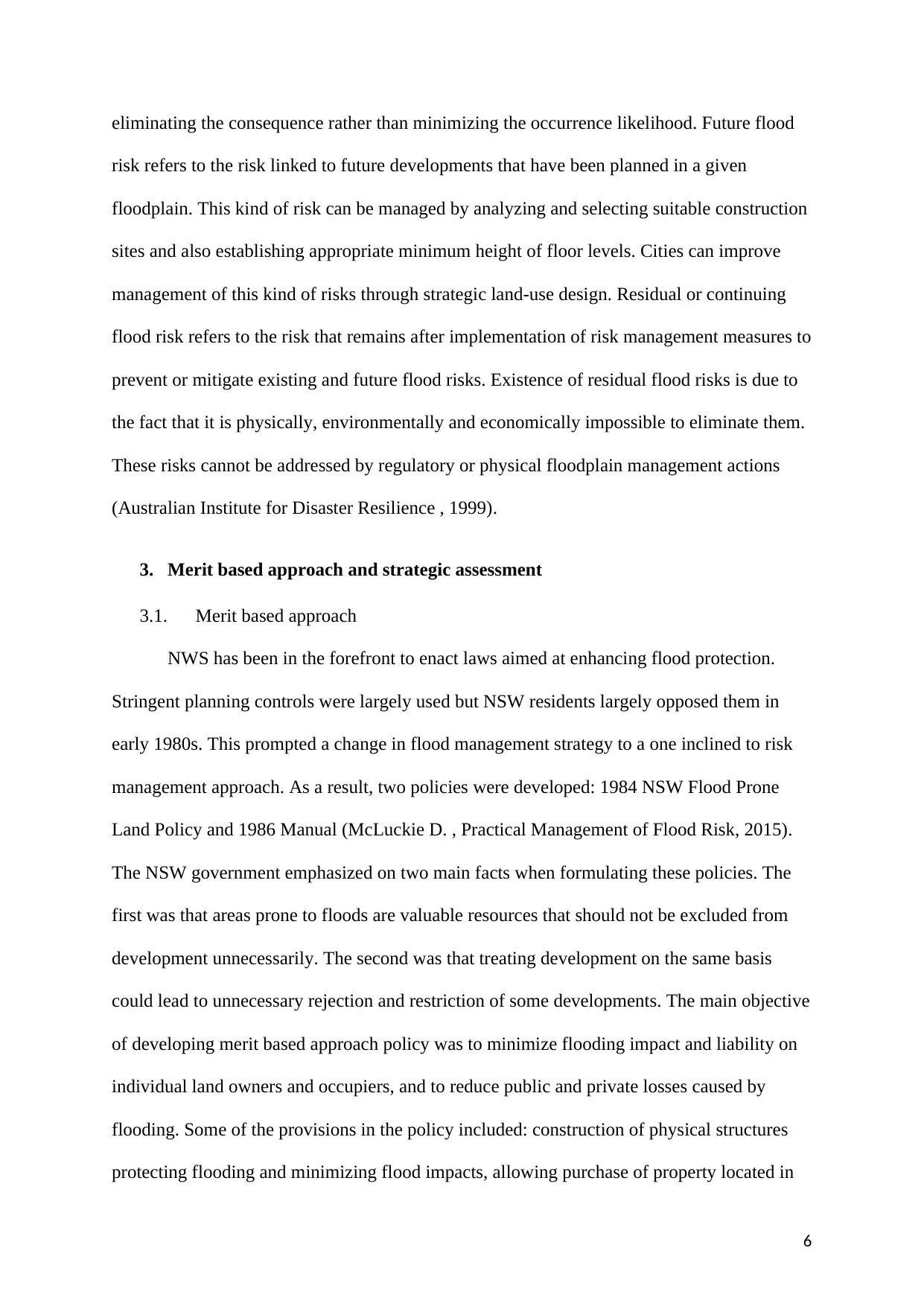
eliminating the consequence rather than minimizing the occurrence likelihood. Future flood
risk refers to the risk linked to future developments that have been planned in a given
floodplain. This kind of risk can be managed by analyzing and selecting suitable construction
sites and also establishing appropriate minimum height of floor levels. Cities can improve
management of this kind of risks through strategic land-use design. Residual or continuing
flood risk refers to the risk that remains after implementation of risk management measures to
prevent or mitigate existing and future flood risks. Existence of residual flood risks is due to
the fact that it is physically, environmentally and economically impossible to eliminate them.
These risks cannot be addressed by regulatory or physical floodplain management actions
(Australian Institute for Disaster Resilience , 1999).
3. Merit based approach and strategic assessment
3.1. Merit based approach
NWS has been in the forefront to enact laws aimed at enhancing flood protection.
Stringent planning controls were largely used but NSW residents largely opposed them in
early 1980s. This prompted a change in flood management strategy to a one inclined to risk
management approach. As a result, two policies were developed: 1984 NSW Flood Prone
Land Policy and 1986 Manual (McLuckie D. , Practical Management of Flood Risk, 2015).
The NSW government emphasized on two main facts when formulating these policies. The
first was that areas prone to floods are valuable resources that should not be excluded from
development unnecessarily. The second was that treating development on the same basis
could lead to unnecessary rejection and restriction of some developments. The main objective
of developing merit based approach policy was to minimize flooding impact and liability on
individual land owners and occupiers, and to reduce public and private losses caused by
flooding. Some of the provisions in the policy included: construction of physical structures
protecting flooding and minimizing flood impacts, allowing purchase of property located in
6
risk refers to the risk linked to future developments that have been planned in a given
floodplain. This kind of risk can be managed by analyzing and selecting suitable construction
sites and also establishing appropriate minimum height of floor levels. Cities can improve
management of this kind of risks through strategic land-use design. Residual or continuing
flood risk refers to the risk that remains after implementation of risk management measures to
prevent or mitigate existing and future flood risks. Existence of residual flood risks is due to
the fact that it is physically, environmentally and economically impossible to eliminate them.
These risks cannot be addressed by regulatory or physical floodplain management actions
(Australian Institute for Disaster Resilience , 1999).
3. Merit based approach and strategic assessment
3.1. Merit based approach
NWS has been in the forefront to enact laws aimed at enhancing flood protection.
Stringent planning controls were largely used but NSW residents largely opposed them in
early 1980s. This prompted a change in flood management strategy to a one inclined to risk
management approach. As a result, two policies were developed: 1984 NSW Flood Prone
Land Policy and 1986 Manual (McLuckie D. , Practical Management of Flood Risk, 2015).
The NSW government emphasized on two main facts when formulating these policies. The
first was that areas prone to floods are valuable resources that should not be excluded from
development unnecessarily. The second was that treating development on the same basis
could lead to unnecessary rejection and restriction of some developments. The main objective
of developing merit based approach policy was to minimize flooding impact and liability on
individual land owners and occupiers, and to reduce public and private losses caused by
flooding. Some of the provisions in the policy included: construction of physical structures
protecting flooding and minimizing flood impacts, allowing purchase of property located in
6
Paraphrase This Document
Need a fresh take? Get an instant paraphrase of this document with our AI Paraphraser
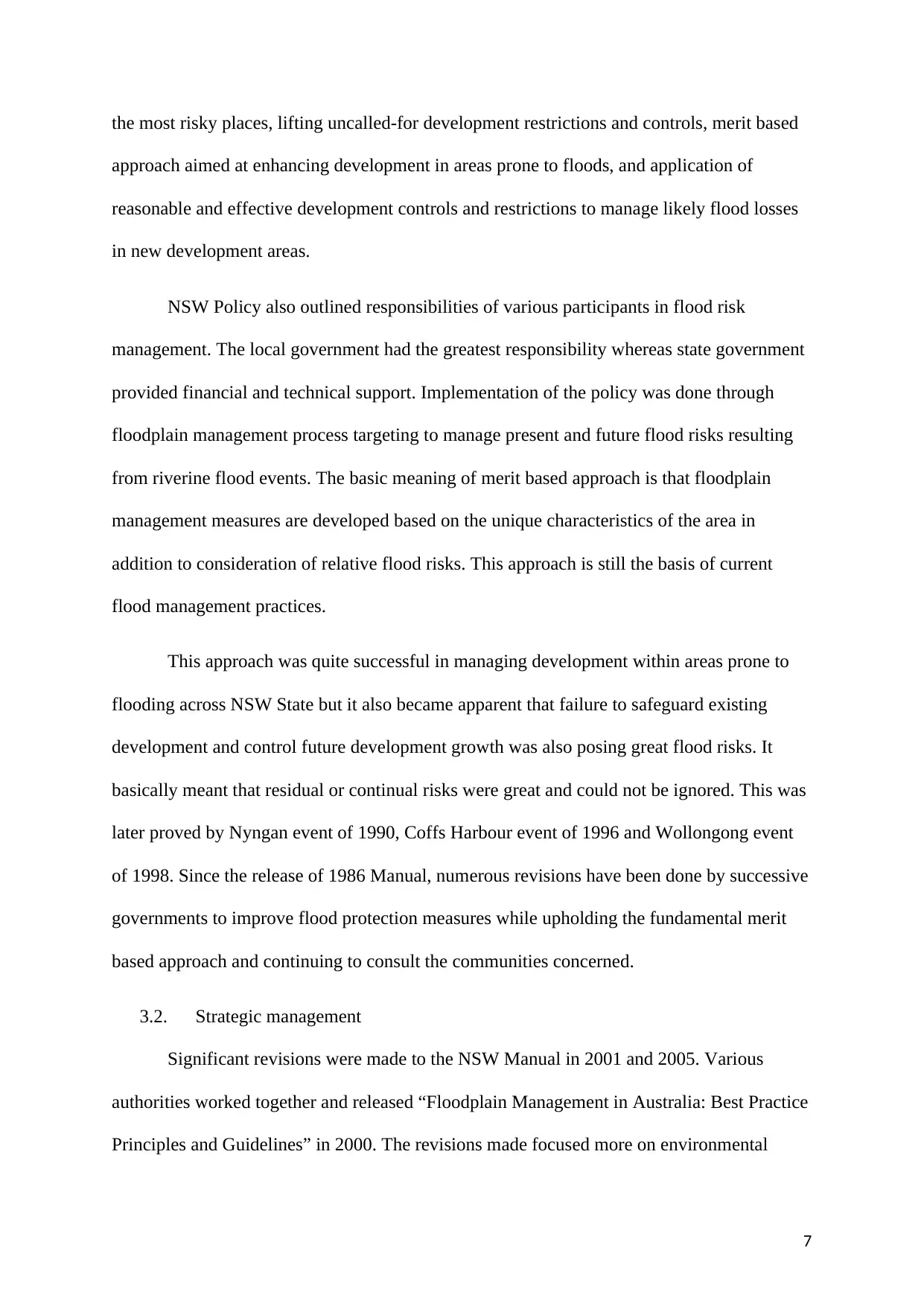
the most risky places, lifting uncalled-for development restrictions and controls, merit based
approach aimed at enhancing development in areas prone to floods, and application of
reasonable and effective development controls and restrictions to manage likely flood losses
in new development areas.
NSW Policy also outlined responsibilities of various participants in flood risk
management. The local government had the greatest responsibility whereas state government
provided financial and technical support. Implementation of the policy was done through
floodplain management process targeting to manage present and future flood risks resulting
from riverine flood events. The basic meaning of merit based approach is that floodplain
management measures are developed based on the unique characteristics of the area in
addition to consideration of relative flood risks. This approach is still the basis of current
flood management practices.
This approach was quite successful in managing development within areas prone to
flooding across NSW State but it also became apparent that failure to safeguard existing
development and control future development growth was also posing great flood risks. It
basically meant that residual or continual risks were great and could not be ignored. This was
later proved by Nyngan event of 1990, Coffs Harbour event of 1996 and Wollongong event
of 1998. Since the release of 1986 Manual, numerous revisions have been done by successive
governments to improve flood protection measures while upholding the fundamental merit
based approach and continuing to consult the communities concerned.
3.2. Strategic management
Significant revisions were made to the NSW Manual in 2001 and 2005. Various
authorities worked together and released “Floodplain Management in Australia: Best Practice
Principles and Guidelines” in 2000. The revisions made focused more on environmental
7
approach aimed at enhancing development in areas prone to floods, and application of
reasonable and effective development controls and restrictions to manage likely flood losses
in new development areas.
NSW Policy also outlined responsibilities of various participants in flood risk
management. The local government had the greatest responsibility whereas state government
provided financial and technical support. Implementation of the policy was done through
floodplain management process targeting to manage present and future flood risks resulting
from riverine flood events. The basic meaning of merit based approach is that floodplain
management measures are developed based on the unique characteristics of the area in
addition to consideration of relative flood risks. This approach is still the basis of current
flood management practices.
This approach was quite successful in managing development within areas prone to
flooding across NSW State but it also became apparent that failure to safeguard existing
development and control future development growth was also posing great flood risks. It
basically meant that residual or continual risks were great and could not be ignored. This was
later proved by Nyngan event of 1990, Coffs Harbour event of 1996 and Wollongong event
of 1998. Since the release of 1986 Manual, numerous revisions have been done by successive
governments to improve flood protection measures while upholding the fundamental merit
based approach and continuing to consult the communities concerned.
3.2. Strategic management
Significant revisions were made to the NSW Manual in 2001 and 2005. Various
authorities worked together and released “Floodplain Management in Australia: Best Practice
Principles and Guidelines” in 2000. The revisions made focused more on environmental
7
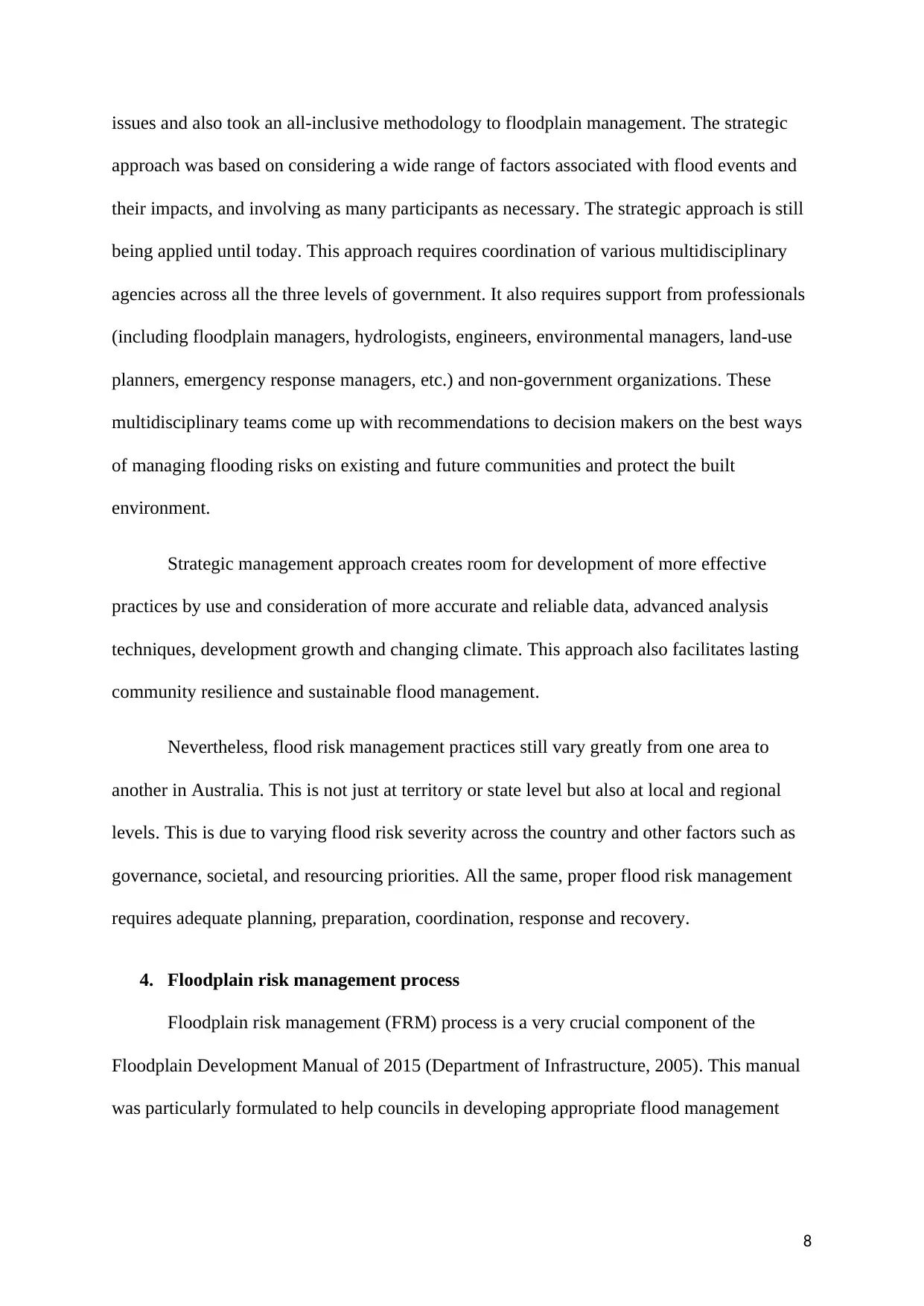
issues and also took an all-inclusive methodology to floodplain management. The strategic
approach was based on considering a wide range of factors associated with flood events and
their impacts, and involving as many participants as necessary. The strategic approach is still
being applied until today. This approach requires coordination of various multidisciplinary
agencies across all the three levels of government. It also requires support from professionals
(including floodplain managers, hydrologists, engineers, environmental managers, land-use
planners, emergency response managers, etc.) and non-government organizations. These
multidisciplinary teams come up with recommendations to decision makers on the best ways
of managing flooding risks on existing and future communities and protect the built
environment.
Strategic management approach creates room for development of more effective
practices by use and consideration of more accurate and reliable data, advanced analysis
techniques, development growth and changing climate. This approach also facilitates lasting
community resilience and sustainable flood management.
Nevertheless, flood risk management practices still vary greatly from one area to
another in Australia. This is not just at territory or state level but also at local and regional
levels. This is due to varying flood risk severity across the country and other factors such as
governance, societal, and resourcing priorities. All the same, proper flood risk management
requires adequate planning, preparation, coordination, response and recovery.
4. Floodplain risk management process
Floodplain risk management (FRM) process is a very crucial component of the
Floodplain Development Manual of 2015 (Department of Infrastructure, 2005). This manual
was particularly formulated to help councils in developing appropriate flood management
8
approach was based on considering a wide range of factors associated with flood events and
their impacts, and involving as many participants as necessary. The strategic approach is still
being applied until today. This approach requires coordination of various multidisciplinary
agencies across all the three levels of government. It also requires support from professionals
(including floodplain managers, hydrologists, engineers, environmental managers, land-use
planners, emergency response managers, etc.) and non-government organizations. These
multidisciplinary teams come up with recommendations to decision makers on the best ways
of managing flooding risks on existing and future communities and protect the built
environment.
Strategic management approach creates room for development of more effective
practices by use and consideration of more accurate and reliable data, advanced analysis
techniques, development growth and changing climate. This approach also facilitates lasting
community resilience and sustainable flood management.
Nevertheless, flood risk management practices still vary greatly from one area to
another in Australia. This is not just at territory or state level but also at local and regional
levels. This is due to varying flood risk severity across the country and other factors such as
governance, societal, and resourcing priorities. All the same, proper flood risk management
requires adequate planning, preparation, coordination, response and recovery.
4. Floodplain risk management process
Floodplain risk management (FRM) process is a very crucial component of the
Floodplain Development Manual of 2015 (Department of Infrastructure, 2005). This manual
was particularly formulated to help councils in developing appropriate flood management
8
⊘ This is a preview!⊘
Do you want full access?
Subscribe today to unlock all pages.

Trusted by 1+ million students worldwide
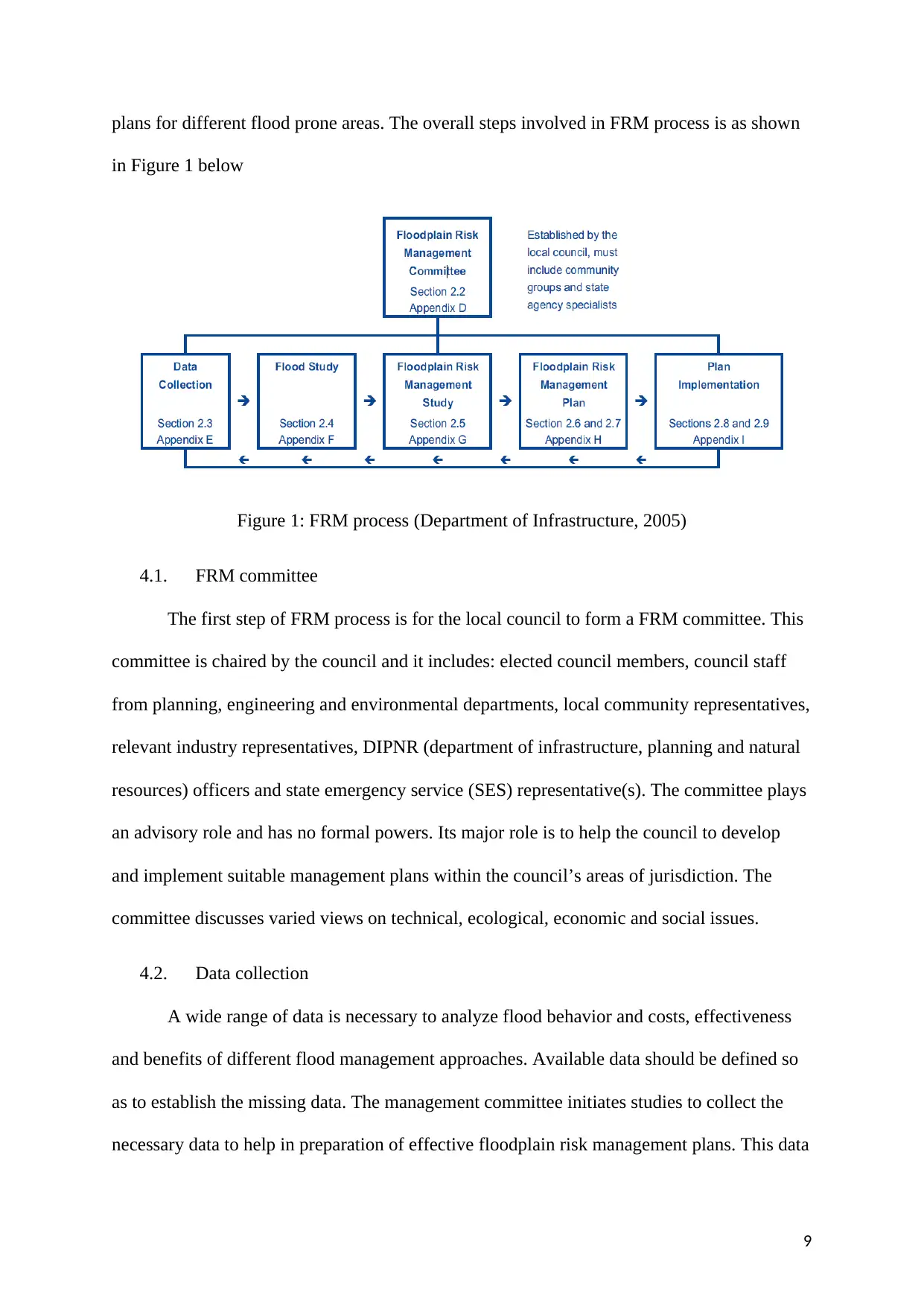
plans for different flood prone areas. The overall steps involved in FRM process is as shown
in Figure 1 below
Figure 1: FRM process (Department of Infrastructure, 2005)
4.1. FRM committee
The first step of FRM process is for the local council to form a FRM committee. This
committee is chaired by the council and it includes: elected council members, council staff
from planning, engineering and environmental departments, local community representatives,
relevant industry representatives, DIPNR (department of infrastructure, planning and natural
resources) officers and state emergency service (SES) representative(s). The committee plays
an advisory role and has no formal powers. Its major role is to help the council to develop
and implement suitable management plans within the council’s areas of jurisdiction. The
committee discusses varied views on technical, ecological, economic and social issues.
4.2. Data collection
A wide range of data is necessary to analyze flood behavior and costs, effectiveness
and benefits of different flood management approaches. Available data should be defined so
as to establish the missing data. The management committee initiates studies to collect the
necessary data to help in preparation of effective floodplain risk management plans. This data
9
in Figure 1 below
Figure 1: FRM process (Department of Infrastructure, 2005)
4.1. FRM committee
The first step of FRM process is for the local council to form a FRM committee. This
committee is chaired by the council and it includes: elected council members, council staff
from planning, engineering and environmental departments, local community representatives,
relevant industry representatives, DIPNR (department of infrastructure, planning and natural
resources) officers and state emergency service (SES) representative(s). The committee plays
an advisory role and has no formal powers. Its major role is to help the council to develop
and implement suitable management plans within the council’s areas of jurisdiction. The
committee discusses varied views on technical, ecological, economic and social issues.
4.2. Data collection
A wide range of data is necessary to analyze flood behavior and costs, effectiveness
and benefits of different flood management approaches. Available data should be defined so
as to establish the missing data. The management committee initiates studies to collect the
necessary data to help in preparation of effective floodplain risk management plans. This data
9
Paraphrase This Document
Need a fresh take? Get an instant paraphrase of this document with our AI Paraphraser
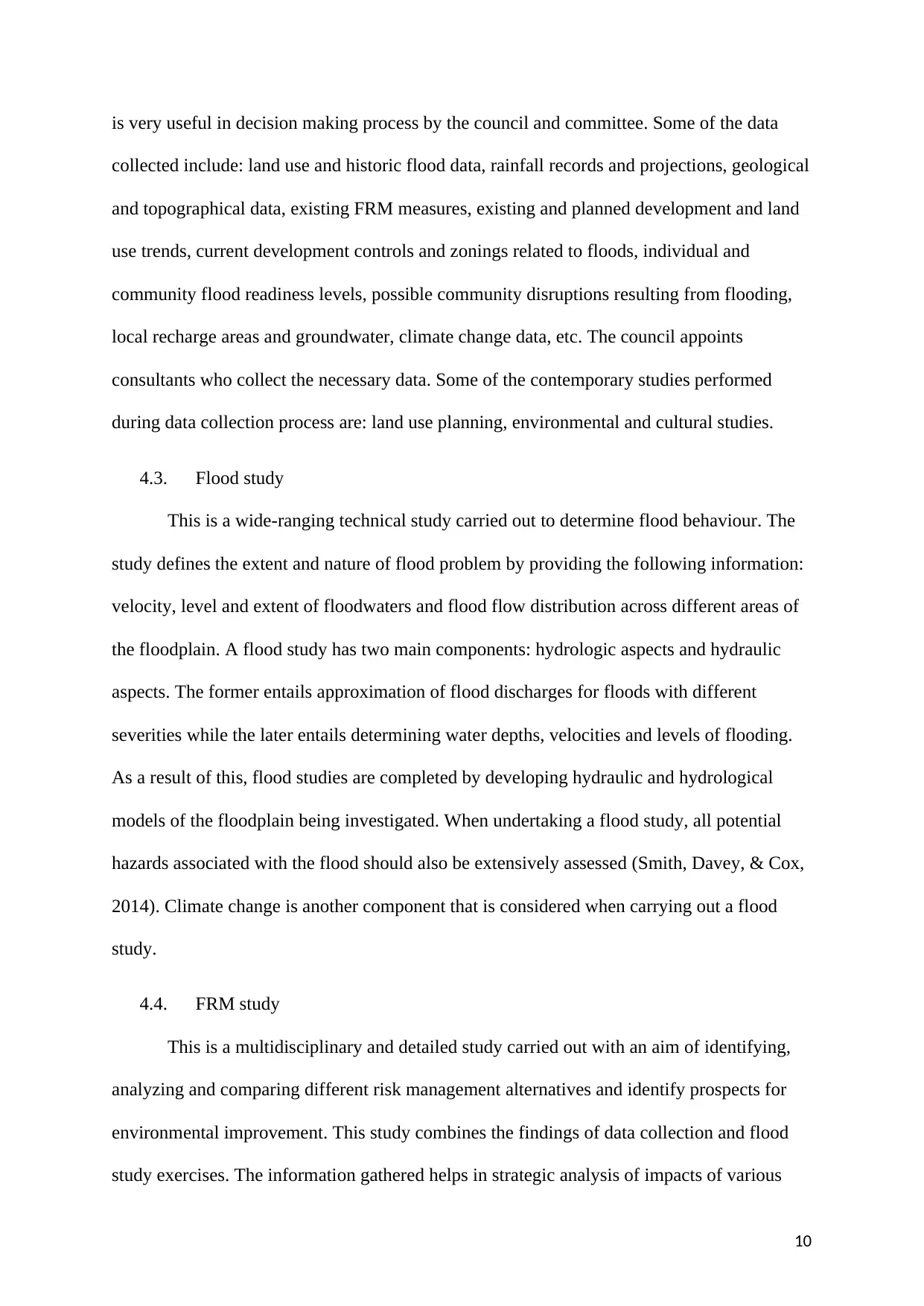
is very useful in decision making process by the council and committee. Some of the data
collected include: land use and historic flood data, rainfall records and projections, geological
and topographical data, existing FRM measures, existing and planned development and land
use trends, current development controls and zonings related to floods, individual and
community flood readiness levels, possible community disruptions resulting from flooding,
local recharge areas and groundwater, climate change data, etc. The council appoints
consultants who collect the necessary data. Some of the contemporary studies performed
during data collection process are: land use planning, environmental and cultural studies.
4.3. Flood study
This is a wide-ranging technical study carried out to determine flood behaviour. The
study defines the extent and nature of flood problem by providing the following information:
velocity, level and extent of floodwaters and flood flow distribution across different areas of
the floodplain. A flood study has two main components: hydrologic aspects and hydraulic
aspects. The former entails approximation of flood discharges for floods with different
severities while the later entails determining water depths, velocities and levels of flooding.
As a result of this, flood studies are completed by developing hydraulic and hydrological
models of the floodplain being investigated. When undertaking a flood study, all potential
hazards associated with the flood should also be extensively assessed (Smith, Davey, & Cox,
2014). Climate change is another component that is considered when carrying out a flood
study.
4.4. FRM study
This is a multidisciplinary and detailed study carried out with an aim of identifying,
analyzing and comparing different risk management alternatives and identify prospects for
environmental improvement. This study combines the findings of data collection and flood
study exercises. The information gathered helps in strategic analysis of impacts of various
10
collected include: land use and historic flood data, rainfall records and projections, geological
and topographical data, existing FRM measures, existing and planned development and land
use trends, current development controls and zonings related to floods, individual and
community flood readiness levels, possible community disruptions resulting from flooding,
local recharge areas and groundwater, climate change data, etc. The council appoints
consultants who collect the necessary data. Some of the contemporary studies performed
during data collection process are: land use planning, environmental and cultural studies.
4.3. Flood study
This is a wide-ranging technical study carried out to determine flood behaviour. The
study defines the extent and nature of flood problem by providing the following information:
velocity, level and extent of floodwaters and flood flow distribution across different areas of
the floodplain. A flood study has two main components: hydrologic aspects and hydraulic
aspects. The former entails approximation of flood discharges for floods with different
severities while the later entails determining water depths, velocities and levels of flooding.
As a result of this, flood studies are completed by developing hydraulic and hydrological
models of the floodplain being investigated. When undertaking a flood study, all potential
hazards associated with the flood should also be extensively assessed (Smith, Davey, & Cox,
2014). Climate change is another component that is considered when carrying out a flood
study.
4.4. FRM study
This is a multidisciplinary and detailed study carried out with an aim of identifying,
analyzing and comparing different risk management alternatives and identify prospects for
environmental improvement. This study combines the findings of data collection and flood
study exercises. The information gathered helps in strategic analysis of impacts of various
10
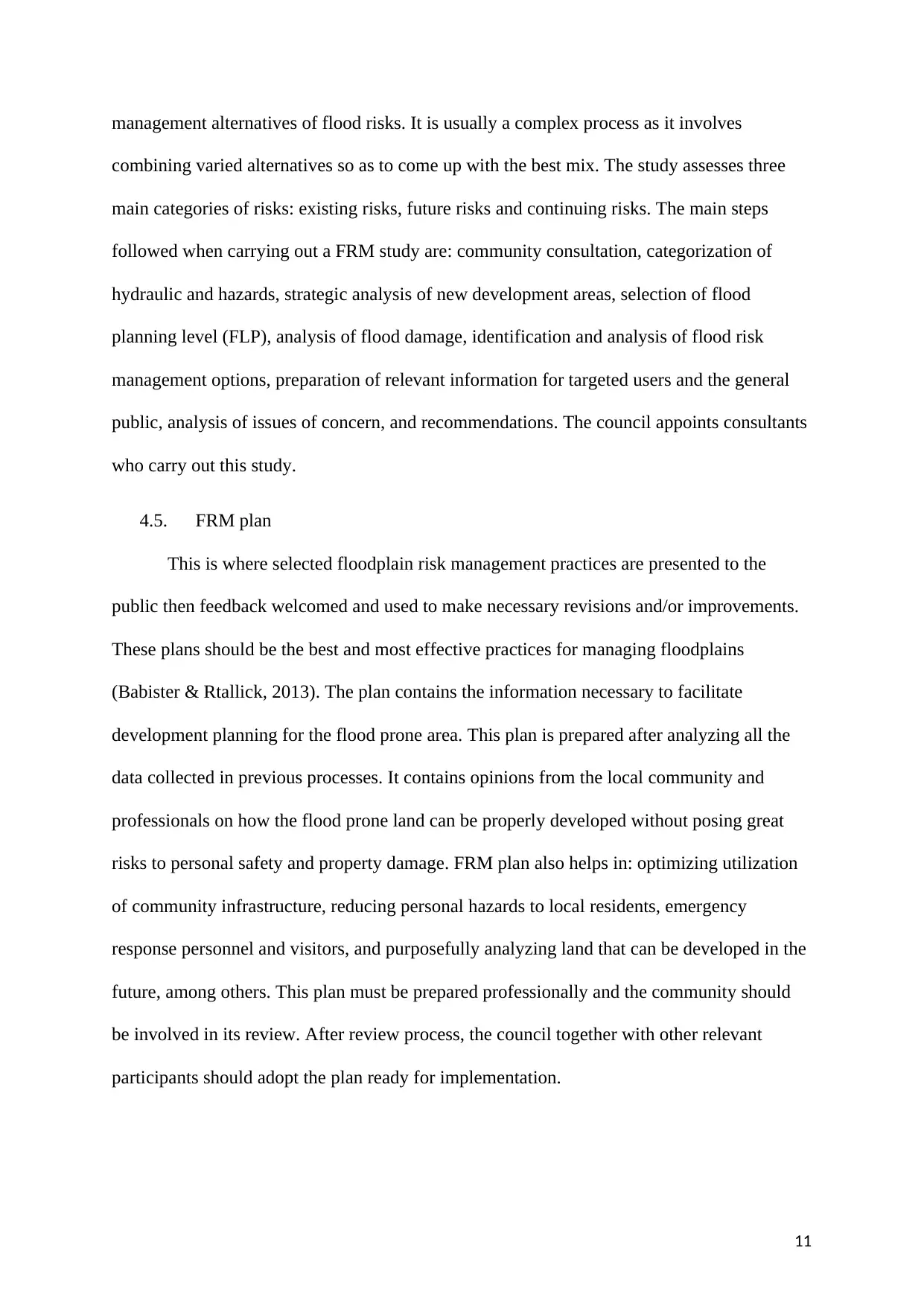
management alternatives of flood risks. It is usually a complex process as it involves
combining varied alternatives so as to come up with the best mix. The study assesses three
main categories of risks: existing risks, future risks and continuing risks. The main steps
followed when carrying out a FRM study are: community consultation, categorization of
hydraulic and hazards, strategic analysis of new development areas, selection of flood
planning level (FLP), analysis of flood damage, identification and analysis of flood risk
management options, preparation of relevant information for targeted users and the general
public, analysis of issues of concern, and recommendations. The council appoints consultants
who carry out this study.
4.5. FRM plan
This is where selected floodplain risk management practices are presented to the
public then feedback welcomed and used to make necessary revisions and/or improvements.
These plans should be the best and most effective practices for managing floodplains
(Babister & Rtallick, 2013). The plan contains the information necessary to facilitate
development planning for the flood prone area. This plan is prepared after analyzing all the
data collected in previous processes. It contains opinions from the local community and
professionals on how the flood prone land can be properly developed without posing great
risks to personal safety and property damage. FRM plan also helps in: optimizing utilization
of community infrastructure, reducing personal hazards to local residents, emergency
response personnel and visitors, and purposefully analyzing land that can be developed in the
future, among others. This plan must be prepared professionally and the community should
be involved in its review. After review process, the council together with other relevant
participants should adopt the plan ready for implementation.
11
combining varied alternatives so as to come up with the best mix. The study assesses three
main categories of risks: existing risks, future risks and continuing risks. The main steps
followed when carrying out a FRM study are: community consultation, categorization of
hydraulic and hazards, strategic analysis of new development areas, selection of flood
planning level (FLP), analysis of flood damage, identification and analysis of flood risk
management options, preparation of relevant information for targeted users and the general
public, analysis of issues of concern, and recommendations. The council appoints consultants
who carry out this study.
4.5. FRM plan
This is where selected floodplain risk management practices are presented to the
public then feedback welcomed and used to make necessary revisions and/or improvements.
These plans should be the best and most effective practices for managing floodplains
(Babister & Rtallick, 2013). The plan contains the information necessary to facilitate
development planning for the flood prone area. This plan is prepared after analyzing all the
data collected in previous processes. It contains opinions from the local community and
professionals on how the flood prone land can be properly developed without posing great
risks to personal safety and property damage. FRM plan also helps in: optimizing utilization
of community infrastructure, reducing personal hazards to local residents, emergency
response personnel and visitors, and purposefully analyzing land that can be developed in the
future, among others. This plan must be prepared professionally and the community should
be involved in its review. After review process, the council together with other relevant
participants should adopt the plan ready for implementation.
11
⊘ This is a preview!⊘
Do you want full access?
Subscribe today to unlock all pages.

Trusted by 1+ million students worldwide
1 out of 21
Your All-in-One AI-Powered Toolkit for Academic Success.
+13062052269
info@desklib.com
Available 24*7 on WhatsApp / Email
![[object Object]](/_next/static/media/star-bottom.7253800d.svg)
Unlock your academic potential
Copyright © 2020–2025 A2Z Services. All Rights Reserved. Developed and managed by ZUCOL.
